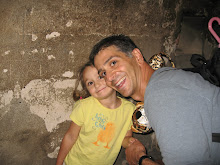This month Dante’s Inferno has gotten a lot of media attention. By Dante’s Inferno, I don’t mean the great poem. Xbox just released a game entitled Dante’s Inferno, in which players lead a buff warrior-knight, Dante, through the nine levels of hell. He must battle his way to the very bottom to save the soul of his beloved Beatrice, who had been kidnapped by Lucifer.
I write that Xbox’s game is “entitled” Dante’s Inferno and not “based on it” because it bears little resemblance to Dante’s poem. In the poem, Dante journeys through hell and interacts with the damned. There is some action, as when his enemy Filippo Argenti tries to grab him. But it is nothing like game character blasting his way through a horde of unbaptized babies in Limbo. Xbox kept Dante’s infernal topography and the names “Dante,” “Virgil” and “Beatrice.” But they changed everything else to make a more exciting game. Indeed, in the poem, Beatrice is a heavenly being who Saves Dante. “Saves” with a capital “s,” because her intervention allows him to turn from sin towards redemption.
Xbox’s game raises the question of the difficult relationship between mass media and the arts. When mass media—movies, TV shows, and now video games—are based on literary works, they have to transform the texts, sometimes dramatically. Film scripts need to shorten and condense the plots of novels; they have to simplify complex ideas, and put them in the mouths of characters. No one would play a game literally based on Dante’s “Inferno”—it’d be too plain dull!
Of course, there is a positive side when mass media is based on literature. Games and films generate interest in the works among people who otherwise might not read them. And when they are successful, more interest—and sometimes money—goes toward the works and the people who study them.
What causes consternation among readers of those works is not so much how the media alter them. That is to be expected. It’s how the new versions actually supplant the originals in many people’s minds. The show (or game) becomes the new “standard,” and has the tendency to marginalize the original. JK Rowling’s books are rich, nuanced works, which the films strip down to their most simplistic form. Yet for as many times as I’ve read all of them, I can’t help but picture Harry Potter as Daniel Radcliff.
At times, people expect the original to have the changes—and the special effects—of the latest movie, TV show, or game. Worse still, others don’t realize that those changes have nothing to do with the original.
Case in point: conjure up the image of a velociraptor—about the size of a man, green lizard-skin, maybe 12 feet long from nose to tail. This is the velociraptor from Steven Spielberg’s Jurassic Park. And it’s incorrect. Scientifically speaking, velociraptors were about 6 feet long, and stood about waist-high to a person. As happens with literary works, the movie-version has totally supplanted the scientific reality in people’s minds.
Oh, and they were probably feathered too.
Sunday, February 21, 2010
Subscribe to:
Post Comments (Atom)




This comment has been removed by a blog administrator.
ReplyDelete